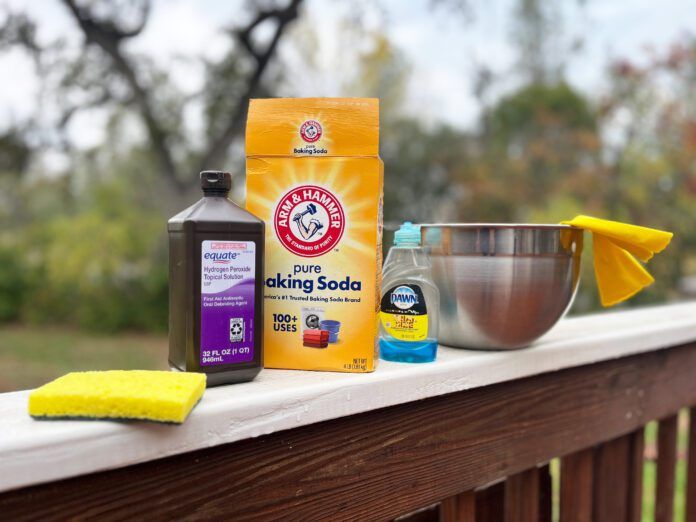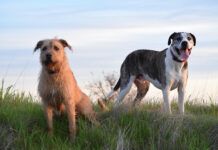Boone got skunked about a couple of weeks ago—and of course, it happened when I stayed up too late watching a movie and I was just about to go to bed. I had taken my foster dog out to pee one last time, hoping to sleep in a bit the next morning, and while I was waiting for her to “go,” Boone managed to find and engage a skunk in another part of our yard. It was a super bummer, because it would be another hour before I could actually go to bed and Boone would be receiving a cold-water bath outdoors, but it wasn’t as bad as it would have been if I hadn’t had two quarts of hydrogen peroxide in the laundry-room closet.
Decades ago, a chemist named Paul Krebaum (may his name be honored forever) cracked the chemical code of the stinky, sulfur-containing substances called “thiols” that are in the musk that skunks spray to defend themselves. According to an article first published in the Chicago Tribune in November 1994, Krebaum, who worked for a company called Molex Inc in Lisle, Illinois, wasn’t trying to solve the skunk-spray problem at the time. He was looking for a substance that could neutralize the smell of other thiols, which are also present in decomposing flesh and fecal matter. In an effort to neutralize foul-smelling thiols in his lab, Krebaum harnessed the power of oxidation, formulating a solution that changes the odorous thiols into odorless acids. He had been using the formula in his lab, but he shared the recipe with a workplace friend who had been complaining about the smell of his cat, who had been skunked. Soon, other scientists heard about the formula and it went viral!
The formula:
1 quart of 3% hydrogen peroxide
¼ cup of baking soda
1-2 teaspoons of dish soap
Mix together in a bucket or large bowl and use immediately.
So simple and inexpensive! And so incredibly effective! But there are some tricks and cautions about how to use it on a “skunked” dog:
- You must not wash the dog with water before using the formula. Water will start to chemically alter the thiols and make their interaction with the “magic” formula slightly less effective.
- You have to use a fresh, unopened bottle of hydrogen peroxide. Using peroxide from a bottle that has been opened and sitting around will be less effective. (Note: You can’t mix this in advance and store it; if you try, you may end up with a huge mess in your under-sink cupboard or wherever you thought you could store it. The combination of baking soda and hydrogen peroxide off-gasses oxygen and can explode whatever container you try to keep it in.)
- If your dog gets skunked on a warm summer day, you are in luck! It’s easiest to keep the dog outdoors while you assemble the ingredients, a bucket, sponge, and a dog shampoo and towels to finish the job. But skunks are nocturnal, and are most active in spring and fall, so almost all of my dogs’ skunk encounters have happened late at night when it’s cold. A kind person would bring them in the house and straight to the bathroom for the de-skunking and post-formula bath—but just walking (or carrying) your dog to the bathroom is going to leave a strong skunk smell in the air of your house that the formula can’t remove! Poor Boone got a cold-hose bath outside. We were both shivering like mad by the time it was done.
- Mix the formula in a clean bucket and use a sponge or washcloth to thoroughly wet your dog from nose to tail with the solution. I recommend starting at the tail end of the dog and working your way forward, because you have to be extremely careful around his eyes, nose, and mouth and will want to rinse the formulas off these areas quickly (and, remember, water will weaken the effectiveness of the formula). The formula really stings if it gets in the dog’s eyes, nose, and mouth (or any cuts you or the dog have have), so you have to wipe it on the dog’s face carefully.
- You will notice that the skunk smell is dramatically reduced almost immediately on contact with the formula—but, with the exception of the dog’s face, let it remain in contact with the dog’s coat for at least a minute or two before rinsing the dog thoroughly with water. Knowing it can sting their lips and mouth, and because you cannot prevent them from licking their lips when you are sponging something wet onto to their face, I tend to take pity and rinse the dog’s face fairly quickly. (The skunk smell will disappear immediately, but if you don’t let the formula stay on the dog for at least a minute, it may become evident again any time the dog gets wet in the next few weeks. It won’t be as strong, but it will be apparent!) Rinse them thoroughly!
- Follow with a quick bath with whatever soothing, good-smelling dog shampoo you have on hand and rinse them well. It’s not necessary, but they are all wet already and the nice smell of the shampoo will be a balm for your irritated nostrils.
There are a number of commercial formulas that claim to be effective for removing odors (including skunk) from your dog, but honestly, I haven’t tried any of them for skunks, because why would I? This formula works great! You just have to make sure you have the peroxide on hand at all times, or you will be driving around town in the wee hours of the night or morning, looking for an open supermarket or pharmacy where you can buy quarts of peroxide, all the while your dog is stinking up whatever location you stashed him in while you went out. I’ve been there! And now I buy two new quarts on the day after whatever skunk incident we most recently suffered ( I double the recipe for washing either of my large dogs.)
For tips on reducing the skunk smell on your clothing, shoes, towels, deck or bathroom, and so on, see this document, prepared by the University of Nebraska, Lincoln Extension, Institute of Agriculture and Natural Resources.







I have used a commercial product named “Nature’s Miracle”…It even neutralized the smell of anal gland secretion on the protective seat covers in my vehicle..
That’s good to know, thank you.
Wow, thank you. We have a skunk that wanders through our garden and I know our dogs love to chase her off. I’m going shopping this afternoon for some fresh hydrigen peroxide. I did however get a chuckle about the explosion under the sink, what a great visual LOL
Ah yes. My previous dog Ramses was “Skunk face” for many months after an encounter. A skunk had the misfortune to put a bit of his tail under our fence. While the fence blocked most of the spray I think the skunk got the worst of the encounter as Ramses actually pulled off a bit of the tail.
I keep a large bottle of peroxide for just these instances. He got it mostly in the face. I did his whole body but didn’t do his face, just as much of his head and body as i could. It did take care of the smell but if he got wet, you could smell it ever so slightly.
Nature’s Miracle is fine for accidents in the house but this simple, cheap tired and true method of Dawn, peroxide and baking soda works better than anything on the market. BTW you need to use Dawn specifically because the “carrier” for the skunk stink is oily and it still needs to be removed from the fur.
Was not aware of the unopened bottle of Peroxide but I only use it for the dogs so they are usually unopened.
Typical hydrogen peroxide that is found in drug stores is 3%.
The recipe in article states 2%.
Is that a typo, or should pet owners be looking for the lower 2%?
You are correct! I was typing too fast. It’s been corrected in the article. Thanks!
–NK
Thank you for the clarification, and all you do for WDJ. Longtime supporter!